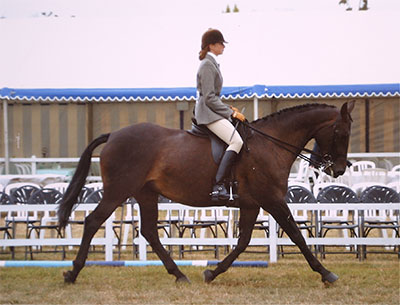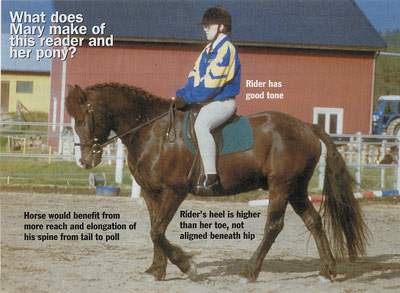RWYM
ARTICLE 13
 The photograph shows a nineteen year old chestnut thoroughbred mare (who I think would win the prize for the oldest horse shown in this column). She looks extremely well and happy, which is particularly impressive as she is a long backed and long necked horse. This type ‘run up light’ very easily, so I hope she winters well and keeps working well into her twenties.
The photograph shows a nineteen year old chestnut thoroughbred mare (who I think would win the prize for the oldest horse shown in this column). She looks extremely well and happy, which is particularly impressive as she is a long backed and long necked horse. This type ‘run up light’ very easily, so I hope she winters well and keeps working well into her twenties.
Her rider has her on loan, and states ‘When I took her on she was totally confused as she had been ridden in entirely the wrong way… She had had riders who liked to ‘jazz’ her up – hence she was tense and hollow.’ She also says, ‘We are learning to relax and go in a nice shape, but it is a long slow job.’
Whilst the tense hollow horse has obviously changed significantly, that change could still become more genuine. The first thing that strikes me about the photograph is the position of the rider’s hands, and I suspect that there is quite a pull on the reins. If we cut them, I don’t think the rider would topple backwards, but I do think that the horse’s head might fly up. To what extent, I wonder, is the rider thinking about bringing the horse’s back up, (i.e. of making a change which is initiated primarily by her body position and mechanics), and to what extent is she thinking about bringing her head down (i.e. of making a change which is initiated primarily by her hand)? This difference is one of the baselines of rider biomecanics, which shows the rider what she has to do to influence the horse with her body instead of her reins.
Rate yourself on the percentages to which you think of either bringing the horse’s head down, or bringing his back up, with those figures adding up to 100%. It is very common for the rider to have 80 or 90% of her attention on the position of the horse’s head and the feeling that she has in the rein. With only 10 or 20% of her attention on her torso and its connection with the horse’s back she can ‘blink and miss it’ for a lifetime .I tell riders that they have to change those figures around, getting at least 80% of their attention on their sitting and the shape of the horse’s back. Only then do they discover the riding skills that are the cornerstone of good rider biomechanics.
This change in attentional focus is often the biggest challenge that faces the rider. We are often taught to focus too much on the horse’s head position, and teaching which boils down to ‘Get that horse’s head down or else!’ is phenomenally destructive. (I hope this is becoming rarer; but I am not so sure that it is.) It results in lots of fiddling and pulling, and often in a very neurotic rider as well as a neurotic horse. If the tactic succeeds at all, the resulting picture usually looks as if the horse’s head has been scrunched backwards, and rarely is there the freedom and the beauty of the horse whose back, and not his head, has been the object of the rider’s attention.
This horse does not show such extreme symptoms, and the rider has obviously done a good job with her. The photograph needs close scrutiny to see its limitations, and whilst the horse’s crest is indeed a curve, it needs to be a much more even curve from wither to poll. At the moment, too much of the curving happens towards the poll, and the base of the neck is rather straight. The highest point of the neck is the place where that little piece of mane is lying to the left, and although we are not actually seeing a break in the neck at the third vertebra (where that piece of mane lies), I fear that this could happen very easily.
The next level of improvement will create a more genuine carriage, in which the poll is the highest point, and the whole of the horse’s back and neck arch upwards. Think of an archer’s bow, with a gradual curve in its entire length, instead of a sudden curve at one end. Once the rider has created the gradual curve throughout the horse, she will trust that she does not need her hands to hold the horse’s head down. If she can take care of the horse’s back, the neck will naturally fall into that curve without any need to pull it into place.
As ever, the answer lies in the rider’s biomechanics, and if the rider improved her sitting I’m sure that the horse would change to match – despite being nineteen and having such a difficult history. So let’s come back to the photograph. I think our rider is pictured in sitting trot, although she could be in the sit phase of rising trot. If this were the case the angle of her torso would be appropriate, but I do not see that she could rise at all, since her hand position would stop her pelvis from moving forward over the pommel.
Within her sitting, she has ‘folded up’ with her shoulders and feet too forward, and her hands and pelvis too back. If we took her horse out from under her by magic, she would land on the arena on her backside, and not on her feet. This breaksone of the fundamental rules of rider biomechanics. Thus our beginning point must be to change her alignment, creating a shoulder/hip/heel vertical line and encouraging her to give her hand forward.
The rider’s feet need to come significantly more back under her, and this will bring her knee further back on the saddle than the knee roll. This change does not require any change in her stirrup length, but a change in the positioning of the thigh and calf. She may then have a gap beneath her knee where she would much prefer to have some padding. Whilst I maintain that the rider’s knee should ideally be on the saddle, sometimes the saddle design prohibits this. You are then left having to act as if it is, whilst avoiding the (seemingly) magnetic attraction of the knee roll. If the saddle is designed so that the shoulder/hip/heel line requires the stirrup leather to hang behind vertical our rider will have even bigger problems. This is often the case with a general purpose saddle, and even with some dressage saddles.
All too often, the rider has the challenge of maintaining her alignment despite the saddle, and I fear that this will be the case here. But this is not the whole story. With her knee further back, her foot further back, and her shoulders further back, our rider will have opened the angle between her torso and her thigh. I imagine that this may stretch some rather short muscles, again making it a difficult position to maintain. But only this change will provide the foundation for giving the hand forward, and discovering how to lift the horse’s back.
Interestingly, in her ‘folded up’ position, the rider’s backside does not stick out behind her. If anything, it looks too tucked under her, which would make her seat bones point forward. It may help her to sit on her hands, and find out exactly how she has to adjust herself to make her seat bones point down. (This is also a valuable exercise when done on a chair. You might like to do it now.) In the correct alignment, our rider will feel as if her pubic bone is more down on the saddle, and it will become easier for her to roll her thigh and knee more inwards, with the bulk of her thigh around to the back (rather than between her thigh bone and the saddle). Once her thighs rotate outwards and her seat bones point forwards her body will again ‘fold up’. Another possible ‘key’ that may help her to maintain the new alignment is thinking of her pubic bone, belly button, sternum and collar bone as a straight and vertical line, which they currently are not.
These changes will have to become relatively easy and familiar in walk before our rider can hope to maintain them in trot. I really encourage her to work her horse in rising trot, and to avoid sitting until she is sure she can maintain them. In rising trot, it will be easier for her to give her hand forward, and to avoid the temptation to fall back into the ‘man-trap’ (the hollow of the horse’s back). In my books and in this column, I have written extensively about the mechanics of rising trot, about how it helps to you match the forces which the horse’s movement exerts on your body. You can therefore more easily learn how to ride your horse ‘from back to front’ instead of ‘from front to back’ – and this is the bottom line.
Riding an older horse can be a good learning opportunity, as you are less likely to be side-tracked by dreams of competitive success. You can focus on building your skills so that you begin work on your next horse from a more correct base-line. This is a good time to go back to the drawing board, and so often you reap a great reward, discovering that by being willing to go slowly and go back to basics, you make progress far faster. You then get far more out of the time you have left with the horse you love now – so you win on both counts.












